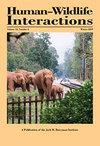香蕉熟了吗?哥伦比亚保护区的安第斯熊与人的冲突
IF 0.9
4区 环境科学与生态学
Q4 BIODIVERSITY CONSERVATION
引用次数: 6
摘要
安第斯熊;熊)是南美洲热带安第斯山脉特有的。此前的评估预测,熊的数量将在未来30年内下降50 - 30%。该物种在哥伦比亚的历史分布中可能面临最大的威胁,在那里,农业向自然栖息地的快速扩张正在加剧人类与熊的冲突。2017年4月至2018年3月,我们在哥伦比亚中部山脉的巴尔巴斯-不来梅保护区研究了熊对大蕉(Musa sapientum)和香蕉(M. paradisiaca)作物的摄食行为,以描述作物损害的程度、经济损失以及最可能发生人熊冲突的摄食地点的空间分布。我们还确定了所有受影响的农民,并使用结构化访谈来确定他们对熊及其保护的态度。我们记录了237个受损植物,并在9个农场确定了57个熊的进食区。熊的损害包括咬伤每棵植物的树干和消耗中心。受损多边形面积198公顷,位于保护区西北部。尽管我们估计该地区因熊的掠夺而损失的大蕉和香蕉产量不到总产量的1%,但接受调查的农民对熊和寻求保护它们的保护组织持消极态度。我们的研究是对哥伦比亚熊消耗作物的规模以及该物种造成的社会和经济损害的首次估计。我们的研究还提供了如何在研究区域减轻人熊冲突的见解。本文章由计算机程序翻译,如有差异,请以英文原文为准。
Is the Banana Ripe? Andean Bear–Human Conflict in a Protected Area of Colombia
The Andean bear (Tremarctos ornatus; bear) is endemic to the tropical Andes Mountains of South America. Previous assessments predict that bear populations will decline by >30% in the next 30 years. The species may face the greatest threats within its historical distribution in Colombia where rapid agricultural expansion into natural habitats is increasing human–bear conflicts. Between April 2017 and March 2018, we studied bear feeding behavior on plantain (Musa sapientum) and banana (M. paradisiaca) crops within the Barbas-Bremen protected area in the central mountain range of Colombia to describe the magnitude of crop damage, economic losses, and spatial distribution of feeding sites where human–bear conflicts would most likely occur. We also identified all affected farmers and used structured interviews to determine their attitudes toward the bears and their conservation. We recorded 237 damaged plants and identified 57 bear feeding area locations on 9 farms. Bear damage consisted of bites to the trunk of each plant and consumption of the centers. The damage polygon covered 198 ha, and it was located in the northwestern portion of the protected area. Although we estimated that <1% of the total plantain and banana production in the area was lost due to bear depredation, surveyed farmers expressed negative attitudes toward bears and conservation groups seeking their protection. Our research is the first estimation of the magnitude of crop consumption by bears and social and economic dimensions of damage caused by the species in Colombia. Our research also provides insights on how human–bear conflicts may be mitigated in the study area.
求助全文
通过发布文献求助,成功后即可免费获取论文全文。
去求助
来源期刊

Human–Wildlife Interactions
Environmental Science-Nature and Landscape Conservation
CiteScore
2.80
自引率
0.00%
发文量
0
审稿时长
11 weeks
期刊介绍:
Human–Wildlife Interactions (HWI) serves the professional needs of the wildlife biologist and manager in the arena of human–wildlife conflicts/interactions, wildlife damage management, and contemporary wildlife management. The intent of HWI is to publish original contributions on all aspects of contemporary wildlife management and human–wildlife interactions with an emphasis on scientific research and management case studies that identify and report innovative conservation strategies, technologies, tools, and partnerships that can enhance human–wildlife interactions by mitigating human–wildlife conflicts through direct and indirect management of wildlife and increased stakeholder engagement. Our intent is to promote a dialogue among wildlife professionals concerning contemporary management issues. As such, we hope to provide a repository for wildlife management science and case studies that document and share manager experiences and lessons learned.
 求助内容:
求助内容: 应助结果提醒方式:
应助结果提醒方式:


